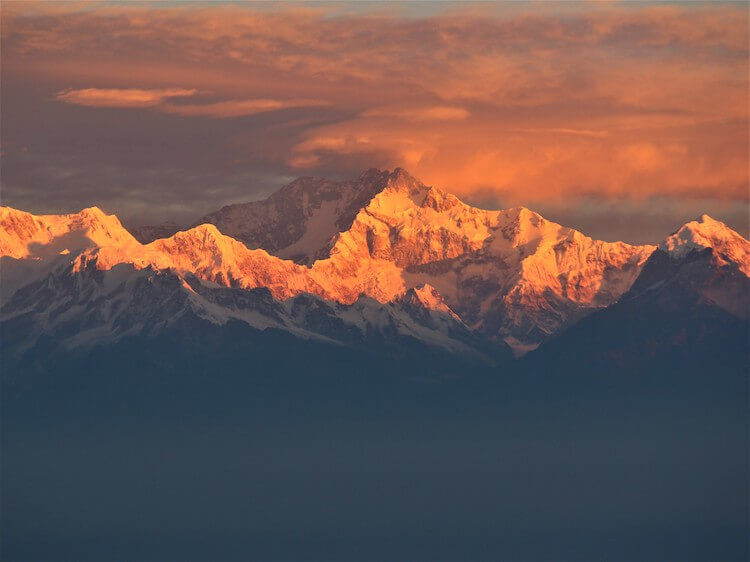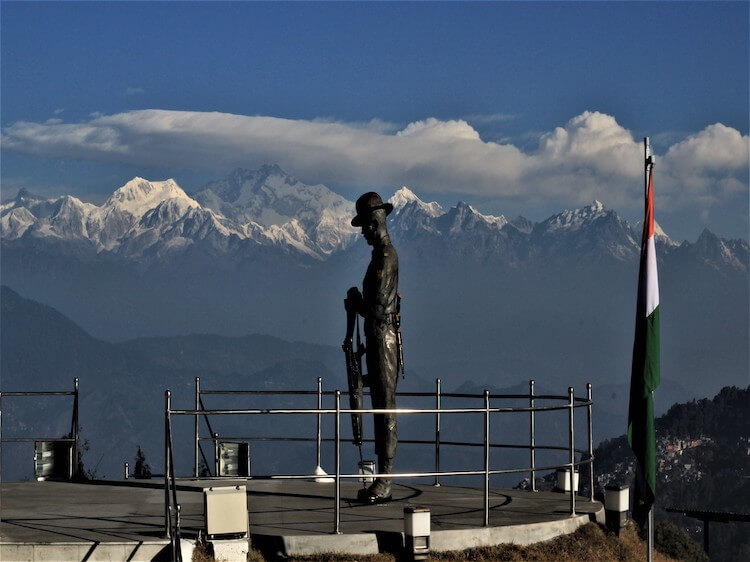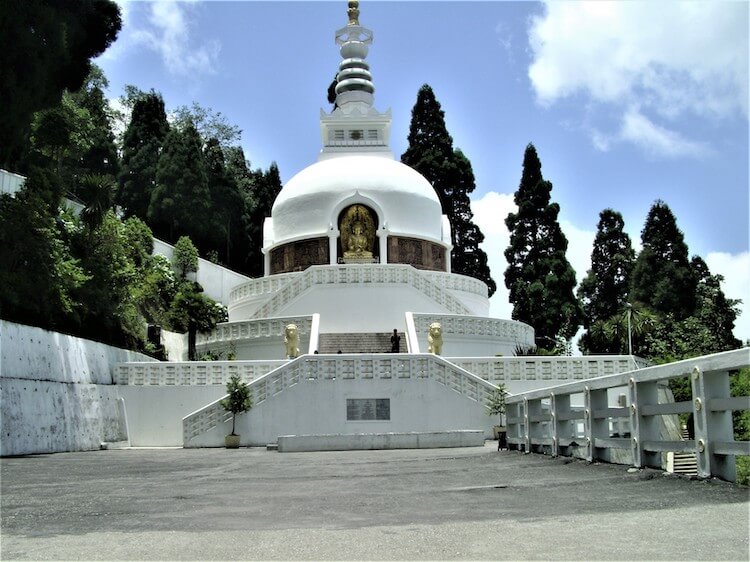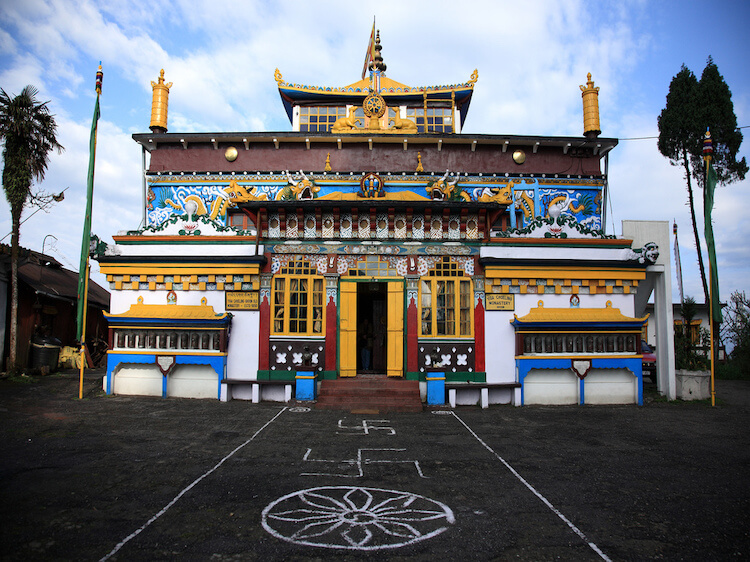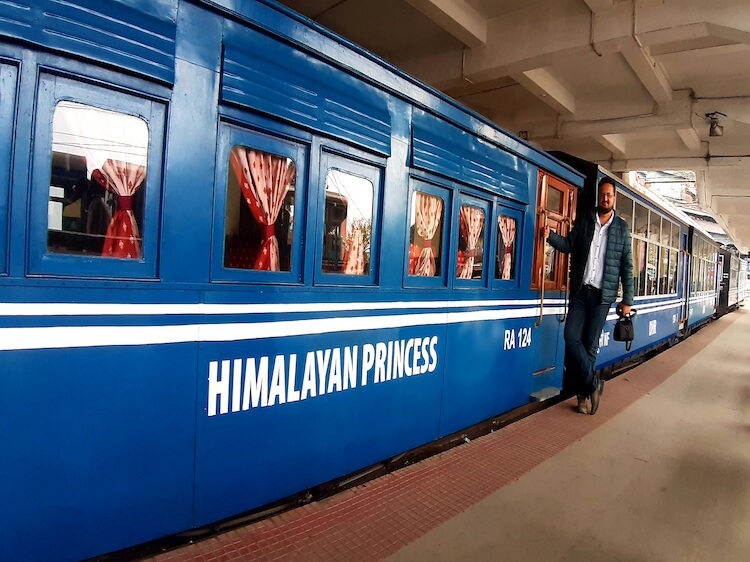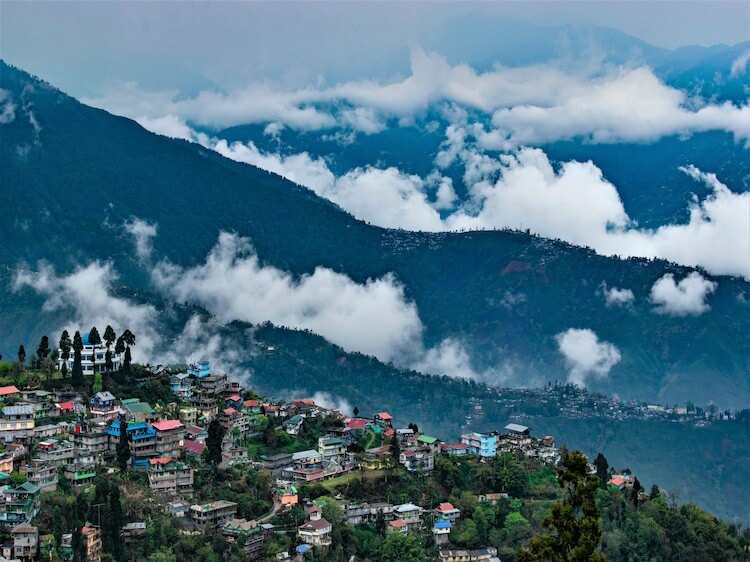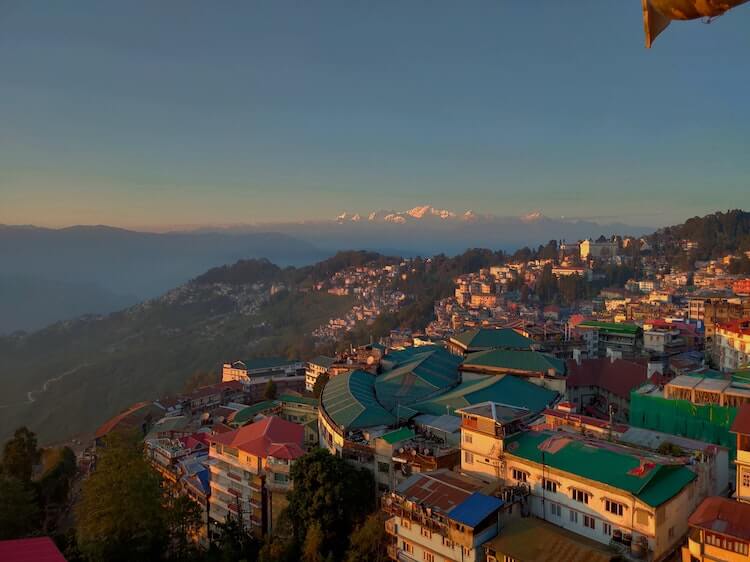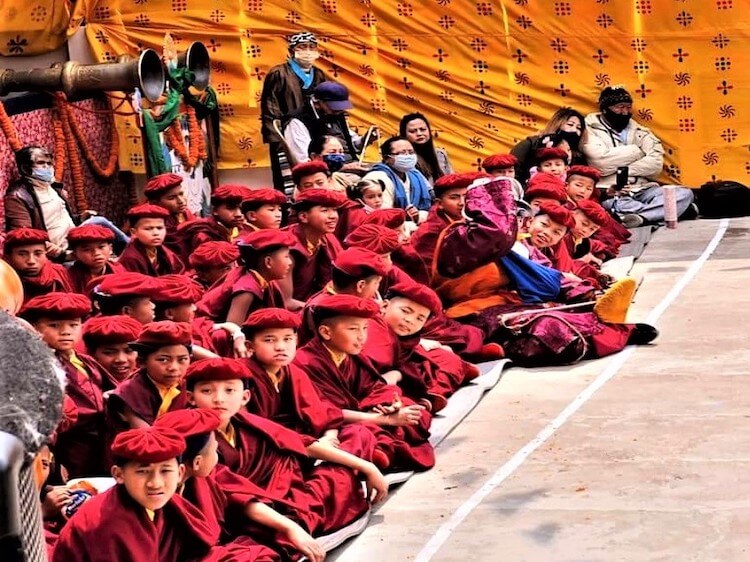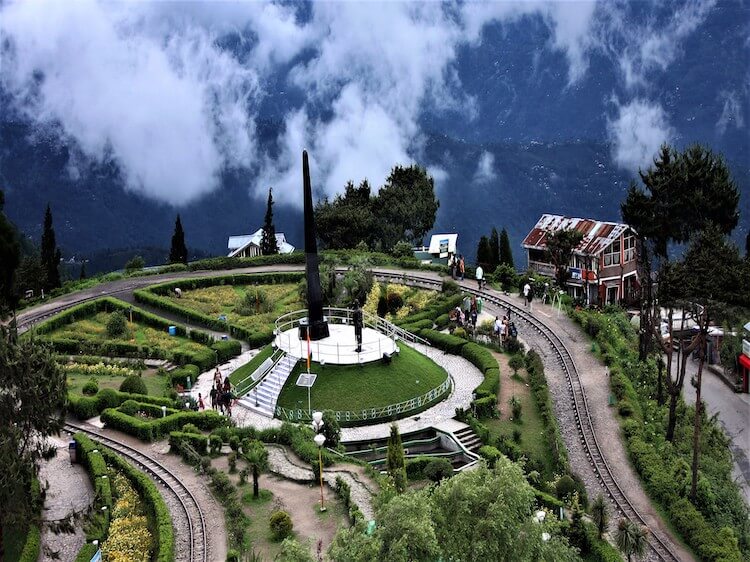Darjeeling
Description
Perched at 2,045m directly opposite the massif of Kanchenjunga, Darjeeling is fascinating hill stations, enticing many to its fairy tale environs. The town’s name said to be derived from ‘Dorji Ling’ – abode of the Thunderbolt – originally a name attached to a monastery while in Sanskrit, this name believed to be emanated from the word ‘Durjay Ling’ means ‘Shiva of invincible prowess, who rules the Himalayas’.
Fondly called ‘Queen of the Hills’, Darjeeling provides a perfect gateway for those seeking to be in harmony with nature. This is the land of the muscatel flavored Darjeeling tea revered by connoisseurs across the globe and also the land of the UNESCO world heritage Darjeeling Himalayan Railway. It is certainly that Darjeeling in the post-modern era comprises of six T’s -Tea, Teak, Tourism, Toy Train, Tiger Hill and Trekkers’ paradise.
| Popular Places |
|
Places of interest in and around Darjeeling
-
1Tiger Hill
Tiger Hill, about 11 km from the town at an elevation of 2,590 meters (8,482 ft) is the highest point in the region offering fascinating views. From the summit, to the north, lies the town of Darjeeling and in the background stands the stupendous snowy range in all its glorious magnificence. Mt. Everest, 225 km away rarely deigns to come out of the cloudy mists, with its two other peaks on each side. About 135 km away is Bhutan’s Chomolhari mountain, said to be the world's most beautiful peak. Kanchenjunga 28,146 ft dwarfing the two others, Kabru (24,000 ft) and Janu (25,300 ft), conical in shape, leaps into view only 64 km away. One of the most unifying forces in myth and identity of the country, the towering range is rightly named Khang-Chen-Dzod-Nga, or the house of five treasures, by scholars, referring to the five summits of this gigantic mountain.
-
2Tibetan Refugee Self-Help Centre
Established in 1959, as a center for the refugees who had fled Tibet with Dalai Lama after the Chinese invasion, it has been developed as workshop for artisans, producing carpets, woolen, woodcarvings, leather items etc. This center has established itself as place for hard work, self-esteem and truth.
-
3Himalayan Mountaineering Institute
A premier mountaineering institute, it provides mountain climbing training to enthusiasts. Following the historical event of the conquest of Mt. Everest by Tenzing Norgay and Edmund Hillary in 1953, the need to establish a mountaineering institute to promote this activity was felt and on 4th November 1954, India’s first Prime Minister, Jawaharlal Nehru laid the foundation stone of this institute. The museum here portrays range of mountaineering equipment those were used in various expeditions and photographs concerning them.
-
4Natural History Museum
It holds representative and comprehensive collection of the fauna of the region. The specimens are displayed in true to life attitudes of all bird species, reptiles and animals found in the different altitudes in the Eastern Himalayas. The butterfly and beetle section merit special mention.
-
5Darjeeling Peace Pagoda
It is established by the Japanese Buddhist order Nipponzan Myohoji. Embedded in the wall of the Pagoda are four statues of Buddha in gold polish and eight carvings on sandstone depicting different stages of Buddha’s life. Just adjacent to this Pagoda is the monastery belonging to the same sect. It is an ideal spot to spend a few quite moments with the sound of the mystic peace mantra ‘NA MU MYO REN GE KYO’ from the monastery.
-
6Ghoom
The last town on the Indo-Nepal frontier, standing at an altitude of 2,257m. It is also the highest railroad station in the world. Ghoom is also the home of a Tibetan Buddhist monastery. Founded in 1875 by Lama Sherab Gyantso for the Yellow Sect of Buddhists, the monastery has a 4.8m. statue of the Maitreya Buddha. It also contains images of Buddha's disciples, Chenrezi and Chongapa. The Buddhist Tibetan gospel, Kangyur, has been preserved here in all its 108 volumes. This monastery is famous for its Tibetan New Year celebrations during February-March, when the monks fly prayer flags in Tibetan tradition and hold religious and folk dances. The Ghoom Rock, a 30.5-m. high rock offering a magnificent view, is also a popular tourist spot.
-
7Bhutia Busty Gompa
Situated at the backdrop of Kanchenjunga range, it is a branch of the Nyingmapa sect’s Phodrang monastery in Sikkim. Decorated tastefully, the monastery also has a library which has a copy of the Tibetan Book of the Dead.
-
8Batasia Loop and War Memorial
This railway loop is an interesting example of engineering feat, which was constructed with the purpose of allowing the toy train to take the sharp drop in altitude between Ghoom and Darjeeling, with ease. From Darjeeling station joy rides in the toy train can be availed of to Batasia Loop and back.
A war memorial was constructed in the space within the loop in 1994. There is also a 30 ft. high triangular cenotaph with the Roll of Honour engrave on it.
It is a fascinating experience to watch the toy train negotiating the loop through the well-manicured gardens of flowers with Kanchenjunga and Darjeeling town in background.
-
9Senchal Lake & Wildlife Sanctuary
A popular scenic place near Tiger Hill, this lake also provides drinking water to the town of Darjeeling. Owing to its attractive location and surrounding, it has now turned up as a popular tourist spot.
Senchal Wildlife Sanctuary is one of the oldest wildlife sanctuaries of India and covers an area of 38.sq. km in elevation ranging from 1,500 to 2,600m. It provides habitat for barking deer, wild boar, Himalayan black bear, Indian leopard, jungle cat, rhesus monkey, Assam macaque, Himalayan flying squirrel and large species of birds.
-
10Sister Nivedita Memorial
Where the mortal remains of Sister Nivedita were cremated, stands the dignified memorial erected by Swami Abhenyanand of the Sri Ramakrishna Vedanta Math. A direct disciple of Sri Ramakrishna, he also built the Ramakrishna Vedanta Ashram in 1924 where religious discourses are held every Sunday.
-
11Japanese Temple
Also known as Nipponzan Myohoji Buddhist Temple, the shrine was built in 1972 and is located 10 minutes away from the Darjeeling town centre, on the hill of Jalapahar. Showcasing classic Japanese style of architecture, this resplendent white building offers visitors a serene and quiet sanctum where one can meditate and seek inner peace.
-
12Chowrasta Mall
Chowrasta meaning ‘where four roads meet’, is a historical public square in the Victoria era hill resort town of Darjeeling. Located in the heart of the town it was the fashionable place of assembly for residents and visitors in the 18th Century. Chowrasta is situated on the ridge of the Darjeeling hill range and is now a focal center of tourist attraction and a popular spot for the residents to assemble, leisure or just stroll in the tranquillity that that part of the hill station offers.
-
13Observatory Hill & Mahakal Mandir
Views of snow-clad peaks, including Mount Kanchenjunga, can be enjoyed from the Observatory Hill. In clear weather, along with Mount Kanchenjungha twelve other peaks, all above 20,000 feet, can be viewed from here.
The sanctity of the elevated abode of the Gods i.e., Mahakal Mandir fills the air of Darjeeling with purity and peace. Serving as the panopticon, it overlooks as well as looks after this hill station, which has changed consistently over the years. Located at the highest crease of the Mall Road or the Chowrasta (as the locals prefer to call it) the way to the Mandir is roughly around a 15- 20-minute walk uphill. The entire complex speaks sanctity as it houses temples of Lord Shiva, Siddhi Sai Baba, Hanuman, Lord Ram, Goddess Kali, Goddess Parvati and many more elaborate idols which demand attention and command power.
-
14Padmaja Naidu Himalayan Zoological Park
This is the only specialized zoo in the country and is internationally recognized for its conservation breeding programmes of Red Panda, Snow Leopards, Tibetan Wolf and other highly endangered animal species of Easter Himalaya. The zoological Park is striving for the maintenance of ecological balance in the Eastern Himalayas with the following objective: (i) Ex-situ Conservation and Captive Breeding of endangered Himalayan animal species, (ii) Education, motivating and initiating awareness campaign among the local people as well as visitors on the importance of conservation of Himalayan Eco-system, (iii)initiating applied research on animal biology, behavior and health care.
It was formerly known as Himalayan Zoological Park and was established on 14th August 1958 as a joint venture of Govt. of India (Department of Science and Technology) and Govt. of West Bengal (Department of Education). In January 1972, the Park was converted into a registered Society which in May 1993 was transferred to the Department of Forests, Govt of West Bengal. At the Govt of India level, the Zoological Park comes under the Ministry of Environment and Forests.
-
15Dali Monastery
This Drukpa Kagyud monastery belonging to the Kagyupa order of Tibetan Buddhism perched atop a hillock at an altitude of 7000 feet. Built in 1971 by Kyabje Thuksey Rimpoche it is one of the largest monasteries in the region in terms of number of monks housed here and also holds vast collection Buddhist literature. The other popular attraction here is Hall of big, cylindrical 6 feet high golden Tibetan prayer wheel which monks keep rotating while offering prayers.
-
16Tenzing & Gombu Rock
Tenzing and Gombu rocks are situated on Lebong Cart Road and face opposite to each other. The huge Tenzing rock is named after Tenzing Norgay, who is famous for climbing Mount Everest accompanied by Edmund Hillary, in the year 1953. Gombu Rock has got its name after Nawang Gombu. He was Tenzing’s nephew and he had climbed the Everest twice and became the first person to do so. He climbed Everest first in the year 1963 and then in the year 1965.
-
17Happy Valley Tea Estate
Established in 1854, it is Darjeeling’s second oldest tea estate, spread over an area of 177 hectares (440 acres) and situated an altitude of 2,100m. The bushes in the garden are really old — the minimum age is 80 years, while some are even 150 years old. Situated around 3 km north of town, this tea estate is the closest to Darjeeling city centre. The months of March to May are the busiest time here when plucking and processing are in progress. The tea estate is open for tourists visit onTuesday to Saturday from 8 a.m. to 4:30 p.m.
-
18St. Andrew’s Church
Named after the patron saint of Scotland, the foundation stone of St. Andrews Church was laid in November 1843, though it was substantially rebuilt in 1873 following the extensive damage sustained by a lightning strike in 1867. Among the first members of the congregation at St. Andrews were the Scottish soldiers and tea planters stationed in Darjeeling. Initially built to accommodate about 200 people, the interior of St. Andrews remains much as it was nearly 170 years ago. Having withstood multiple earthquakes over the years, its overall charm still remains intact to this day.
Lt. Gen. George W. Aylmer Lloyd is credited to have discovered Queen of Hills or Darjeeling in 19th century. Having arrived in Ghoom near Darjeeling in 1828 as part of an East India Company mission to wrest administrative control over the region, Lloyd fell so deeply in love with the area that he never went back home. When he died in 1865, he was, appropriately enough, buried in Darjeeling, where his tombstone, declared a heritage structure by the Archaeological Survey of India, stands to this day. Lt. Gen. George W. Aylmer Lloyd ‘s name most prominently displays within the beautiful St. Andrews Church. Alongside Lloyd are other names engraved on marble and brass plaques, reminding visitors of some of the area’s oldest residents.
-
19Roy Villa
Roy Villa at Darjeeling on the Lebong Cart Road is the building, where Sister Nivedita of India (born Irish and made India her home on behest of the great Swami Vivekananda) breathed her last. ‘The boat is sinking, but I can yet see the sunrise’- these were the last words of this noble soul. This European castle-like structure is around 115 years old and is named after its original owner, Dwarakanath Roy. The building is now under control of Ramkrishna Mission which is currently running the Gadadhar Abhyudaya Prakalpa (Total development programme for poor children) from here and other welfare programmes.
-
20Lloyd Botanical Garden
Lloyd’s Botanical Garden is a ‘one of its kinds’ botanical garden spread over in about 40 acres of land and shelters several endangered and exotic species of fauna. The aim of Lloyd’s Botanical Garden is to preserve the native floral species of Darjeeling Himalayan hill region, Sikkim and its neighbouring regions.
The Botanical Garden is named after William Lloyd, the owner of the Lloyd’s Bank during the British India days. He gifted this sprawling 40 acres where the Botanical Garden was laid out later under the supervision of the superintendent of the garden, Sir George King. The garden was designed in three sections: (1) The upper section consists of the various indigenous Himalayan plantations, (ii) The Middle section has a large variety of fern and conifer trees along with Alpine, (iii) The lower section is filled with colourful exotic plants that were brought from various countries across the globe.
-
21DARJEELING HIMALAYAN RAILWAY (DHR)
Starting from New Jalpaiguri, the little train popularly known as Toy Train travels through the plains till Sukna and then clings uphill to reach the second highest steam locomotive Railway station in the world, Ghoom (alt. 7,408 ft.) before descending nearly thousand feet to reach Darjeeling.
Officially known as the Darjeeling Himalayan Railway, it is as much a pioneering work of achievement, projecting not only its engineering ingenuity but also a historic development of the 19th century British convalescent center in the remote north eastern Himalayas. In 1870, an agent working for the Eastern Bengal Railway came up with a brilliant idea to reduce the costs of transport. His name Franklyn Prestage -- the idea -- the Toy Train. It took eight long years for Prestage to submit his scheme to Lt. Governor Sir Ashley Eden, who gave it immediate sanction. Named the Darjeeling Steam Tramway Co., it was changed to The Darjeeling Himalayan Railway Co. on September 15th, 1881. It remained as such till it was taken over by the Indian Government on Oct. 20, 1948. The construction had begun in 1879 and with the zeal shown by the workers, the first 20 miles from Siliguri to Tindharia station was opened in March 1880 for the Viceroy's special train only. After a further 11 miles to Kurseong were completed, it was opened to the public on August 23 of that year. Sonada was reached on February 1, 1881, the summit of Ghoom on April l4th, 1881 and finally on July 4th, 1881 the baby locomotive and three coaches puffed right through to Darjeeling-a total of 50.75 miles.
The construction of this line is considered a unique engineering feat because of its steep gradient, sharp curves, Z-crossing and loops. There are three loops on this line, Batasia Loop between Ghoom and Darjeeling being the most famous one. Apart from this, the section has five major and 498 minor bridges. The Darjeeling-Himalayan Section has its own workshop at Tindharia where the major overhauling of locomotives, carriages and wagons are undertaken along with manufacturing of spares.

